Picture this: It’s the end of a long day, and you finally settle into bed, ready to drift off to dreamland. But as soon as you close your eyes, you feel a familiar weight on your legs. You peek under the covers, and there it is – your beloved feline companion snugly nestled between your knees.
Have you ever wondered why cats have an uncanny knack for claiming that spot? Join us on a journey through the mysterious world of cat behavior as we uncover why our furry friends choose to sleep between our legs.
Sleep Cycle Of Cats:
Firstly, cats exhibit a behavior pattern known as crepuscular activity, which means their highest energy and activity levels occur around the early hours of dawn and dusk. This is due to their instincts as hunters, who prefer low-light conditions for hunting prey. As such, their sleeping patterns also reflect these tendencies.
Cats have two distinct types of sleep: rapid eye movement (REM) and non-rapid eye movement (NREM).
REM(rapid eye movement) :
During REM sleep, cats dream, and their brain activity increases while their muscles relax. During this stage, you may notice your cat twitching or moving its paws as if chasing something in its dreams.
NREM(non-rapid eye movement):
On the other hand, NREM sleep is when cats experience deep restorative sleep. Their body temperature decreases marginally, and their heartbeat rate reduces. This stage usually lasts about 15-20 minutes before transitioning back into REM sleep.
It’s also noteworthy that cats can fall asleep smoothly and quickly due to their proficiency in instantly entering a state of relaxation. This explains why you may see your cat dozing off mid-day in random places around the house.
Why does your cat choose to sleep between your legs?
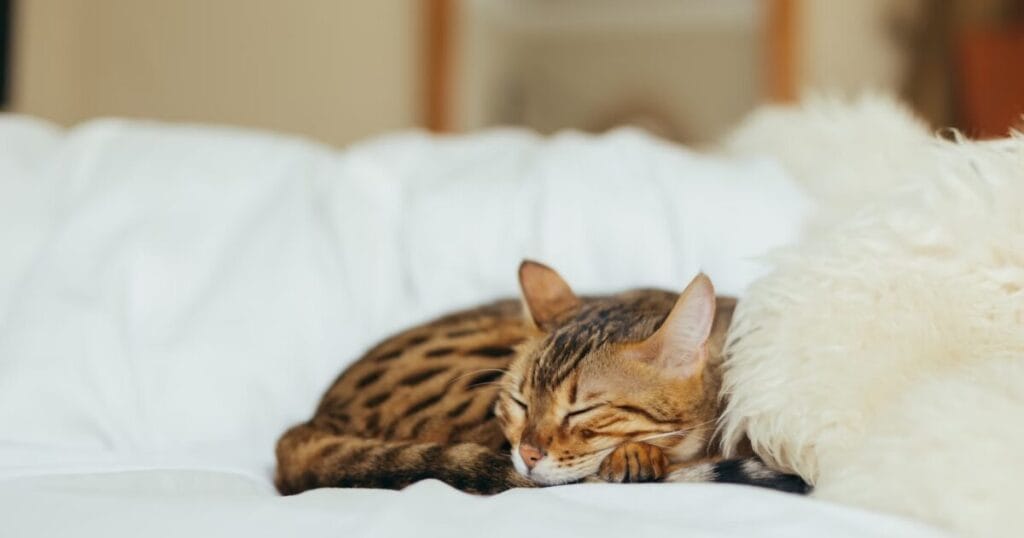
Numerous reasons exist for cats to sleep between their owners’ legs. These reasons may combine instinct, comfort, security, and social behavior. Every cat is unique, so its reasons for this sleeping preference may vary. As pet owners, we must respect our furry friends’ choices and provide them with a safe and comfortable sleeping space.
Security:
Security is vital to cats, and finding a safe spot to sleep is paramount. Firstly, cats are natural burrowers. In the wild, they seek out small, enclosed spaces, such as caves or crevices, to sleep in. This instinctual behavior stems from their ancestors, who needed to hide from predators while they rested. Your cat may see the space between your legs as a safe, warm hiding spot, like a small cave.
When your feline friend chooses to sleep between your legs, they perceive that space as a haven of safety. Your presence provides them with reassurance and protection. By positioning themselves between your limbs, they feel shielded from any potential dangers that may lurk around.
Moreover, sleeping between your legs allows cats to take advantage of the warmth emitted by our bodies. It creates a cozy cocoon-like environment that mimics snuggling up with their litter mates or mothers during kittenhood.
In addition to physical security, cats also find emotional comfort in sleeping between their legs. They have formed strong bonds with us as their owners and see us as trusted companions. Being close to us while we sleep strengthens this bond and offers them an extra sense of reassurance and well-being.
So next time you wake up with a purring ball of fur nestled comfortably between your legs, remember that it’s not just about convenience for them – it’s all about seeking security in every sense!
Comfort and Coziness:
One of the primary reasons is comfort, which is why cats love to sleep between their owner’s legs. When they curl up in that snug spot, it provides them with a sense of security and warmth. The proximity to their owners also allows them to feel safe and protected.
Cats are known for being creatures of comfort. They seek out cozy spots where they can relax and unwind. Sleeping between your legs allows them to find the perfect balance of comfort and companionship. Your body heat adds an extra layer of coziness that they can’t resist.
It’s important to note that every cat is unique regarding what comforts them. Some cats prefer other sleeping spots, such as soft beds or warm blankets, while others find solace between their owner’s legs.
Moreover, when a cat curls up between your legs, it is surrounded by your scent, which brings comfort. Cats have a highly developed sense of smell and can recognize individuals by their scents. The familiar odor helps soothe any anxiety or stress that your feline may be experiencing.
But beyond comfort and security reasons, there could also be some underlying medical issues that make sleeping between our legs appealing for our feline companions. Cats suffering from arthritis or joint pain may find relief by sleeping in this position, as their weight is partially supported by our legs, providing them with a more comfortable and pain-free sleeping experience.
Warmth:
As natural sun-seekers, cats enjoy basking in the warmth of sunlight during the day. At night, when temperatures drop, they seek out alternative heat sources – and what better source than our body heat? Our thighs provide the right warmth to keep our furry friends content as they drift into slumber.
Warmth is a major factor in cats’ behavior and is significant in why they sleep between their owner’s legs. Cats are known for being creatures of comfort, and nothing makes them happier than finding a cozy spot to curl up in. This is especially true when it comes to sleeping. Whether it’s on top of a warm blanket or nestled between your legs, cats will always seek out warmth for their slumber.
This preference for warmth stems from their evolutionary instincts. As descendants of desert-dwelling felines, domesticated cats retain the traits that helped their ancestors survive in harsh environments. In the wild, cats would often huddle together for warmth during cold nights, and this behavior has carried over into their domestic lives.
Deep Sleep:
Cats prefer sleeping between their owner’s legs for deep sleep – here’s why. Cats are known to nap in various spots, be it a sofa, floor, or even a bookshelf, wherever they find comfort. However, when seeking a deeper, more rejuvenating sleep, they often choose a location that feels exceptionally safe. Nestling between their owner’s legs offers them this security, making it an ideal spot for deep sleep.
Cats experience deep sleep much like humans, although their sleep patterns differ. Deep sleep is part of cats’ overall sleep cycle, including light and deep sleep phases.
In the deep sleep phase, cats experience a period called Rapid Eye Movement (REM) sleep. This stage is marked by quick movements of the eyes under closed eyelids.
This stage is crucial for brain development and memory consolidation. In this phase, cats might twitch, move their paws, or even make chirping or twitching sounds, which is normal and indicates that they are dreaming.
Deep sleep is also important for a cat’s physical health. During this time, their bodies can fully relax and repair themselves. Growth hormones are released during deep sleep, essential for kittens’ growth and adult tissue repair.
Even in their deep sleep phase, they remain alert to their surroundings. This trait can be traced back to their wild ancestors, who needed to be ready to wake up and defend themselves or catch prey at a moment’s notice. This is why you might notice that your cat can wake up quickly and appear alert almost immediately, even in a deep sleep.
The area between your legs provides safety and becomes familiar with their scent, adding an extra layer of comfort.
Instinctual Behaviors:
To understand why cats love sleeping between your legs, we must first consider their instincts as animals. Cats are naturally predatory creatures and are constantly on alert for potential threats or prey. By curling up between your legs while you sleep, they can feel safe and protected from any danger that may arise during the night.
Furthermore, in the wild, felines often seek out small enclosed spaces to rest during the day to conserve energy and keep warm. Your legs provide a similar sense of security and warmth for your cat to snuggle up against.
Regulate Body Temperature:
Cats have higher body temperatures than humans – around 101-102 degrees Fahrenheit – and they maintain this temperature by conserving heat through various methods, such as curling up tightly or seeking warm spots. By sleeping between your legs, your cat can benefit from your body heat and more effectively regulate its temperature.
Furthermore, cats also have fur coats that act as insulation against cold temperatures. However, these coats are insufficient to keep them warm during colder seasons or in an air-conditioned room. Therefore, snuggling between your legs provides additional warmth that helps them stay comfortable and cozy.
Likewise, some cat breeds may be more inclined to seek warmth than others due to genetic predispositions or physical characteristics. For example, hairless breeds like Sphynx cats may be more likely to sleep between their owner’s legs to keep warm, while long-haired breeds like Maine Coons may be more resistant to colder temperatures.
Cats sleeping between their owner’s legs is a natural and instinctual behavior driven by their need for warmth, comfort, and security. It’s a sign of trust and affection towards their human companions, and a reminder of the deep-rooted instincts passed down through generations. So the next time your feline friend snuggles up between your legs for a snooze, remember that it’s just another way they show their love for you.
Bonding with their owner:
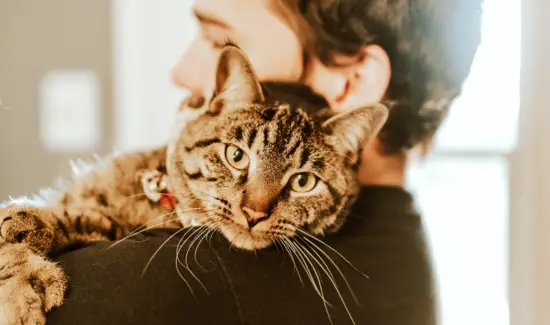
Bonding with their owner is an essential aspect of a cat’s life. Although cats are known for their independence, they also crave affection and love from their owners. One way they show this is by sleeping between their owner’s legs.
While this behavior may seem strange to some, it has a deep-rooted meaning in the feline world. For cats, sleeping between their owner’s legs signifies trust and comfort. It makes them feel safe and secure while close to their beloved human.
The bond between a cat and its owner is built over time through consistent care, love, and attention. When a cat sleeps between your legs, it is a sign that it has developed a strong bond with you. Your presence makes it feel comfortable enough to let its guard down.
Seek Protection:
Furthermore, sleeping between the legs can also be seen as an act of protection for cats. In the wild, cats often sleep in groups for safety reasons. By sleeping between your legs, they seek protection from any potential threats while they rest.
Territorial Marking:
Another possible reason cats sleep between their owner’s legs could be linked to scent-marking behavior. Cats have a variety of scent glands throughout their bodies, including the sides of their face and paws. When they rub against or sleep near you, these glands release pheromones that help them mark you as part of their territory.
Sleeping between your legs can be because it feels suitable for cats! The space between our thighs offers just the right amount of support and security for them to drift off into dreamland comfortably.
But regardless of the reason, it is a sign of a strong bond between the cat and its owner. So next time your furry friend curls up between your legs to sleep, Consider it a compliment and enjoy your special bond with your feline companion.
Reduce Stress and Anxiety:
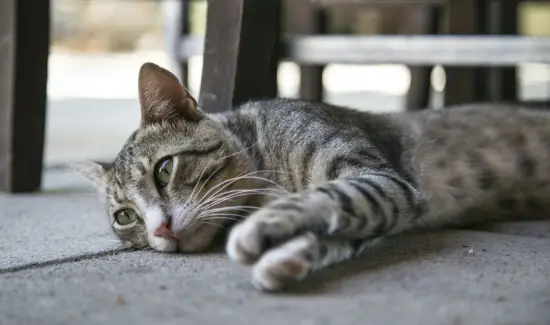
When stressed or anxious, cats often seek comfort in familiar, safe spaces. In fact, it is estimated that up to 40% of cats suffer from some form of anxiety.
Sleeping between an owner’s legs can be soothing, providing a secure, warm, and comforting environment. The owner’s presence helps reduce anxiety levels.
For many cats, being close to their human is a source of comfort and can significantly reduce their stress levels. Listening to the rhythm of your breathing and heartbeat can be relaxing.
By understanding the potential causes and taking appropriate steps to manage these emotions, we can provide our feline friends with a safe and comfortable environment to thrive in.
Vantage Point:
By sleeping between your legs,they feel safe and protected from any potential danger. Moreover, sleeping in this position gives them a strategic vantage point. As natural hunters, cats instinctively seek high places where they can observe their surroundings without being seen themselves.
Sleeping between your legs allows a cat to remain somewhat alert to the environment while still resting. They can sense movements and vibrations through your body, which may alert them to potential dangers or changes in the environment. This position allows them to react quickly if necessary.
From this position, cats can observe their surroundings without exposing themselves too much. It’s a strategic spot where they can watch the room or area they’re in. While it might not provide the height advantage of a perch or tree, it still offers a sense of control over their immediate surroundings.
Routine and Habit:
Felines, our beloved companions, tend to be creatures of routine, and establishing routines is crucial to their lives. When it comes to sleeping between our legs, this behavior often stems from the routine they’ve become accustomed to over time.
Cats are known for being creatures of comfort and seeking warm and cozy slumber spots. By consistently finding solace between your legs, they can create a sense of familiarity and security in their sleeping routine.
Additionally, cats are incredibly perceptive animals who understand our daily patterns. They may have noticed that you stay still during your sleep or provide a warm spot when tucked under the covers. As such, they’ve learned to associate this location with uninterrupted rest and comfort.
Furthermore, cats are highly sensitive beings who thrive on closeness and connection with their human counterparts. Sleeping between your legs allows them to be nearby while feeling safe and protected by your presence.
So, whether you’re snuggling up at night or taking an afternoon nap together, remember that these cozy moments are significant for you and your furry friend. Once cats find a spot where they feel safe and comfortable, they often stick to it as part of their routine. If your cat has found that sleeping between your legs provides a good sleep experience, they are likely to continue this habit.
Alternate Cozy Resting Spots for Your Feline Companion:
Providing perfect sleep Spots for Your Cat’s Comfort ensures it gets the rest it needs.
Alternative sleeping places don’t have to be a nightmare. Experiment, as cats have different preferences, you will eventually find what works best.
A cat bed requires good quality, comfortable materials, and pet-safe options.
Cats often choose to sleep between their owner’s legs for warmth and security, but if you’re looking for alternative comfortable places for your cat to sleep, here are some suggestions:
Cat Bed:
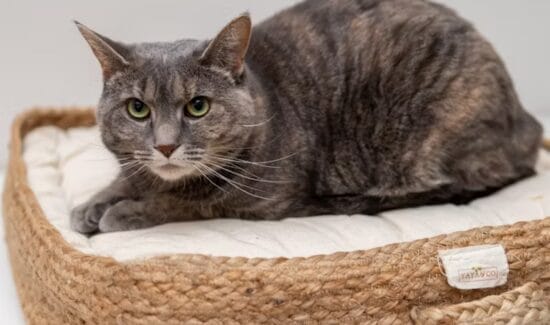
Cat beds are typically the preferred choice when offering our furry feline companions a cozy spot to relax. These specially designed sleeping spots offer a cozy, secure space for cats to curl up and relax.
Cat beds are available in diverse shapes, sizes, and styles, catering to various preferences and tastes. From simple cushioned mats to more elaborate nest-like designs, there is something for every kitty’s taste. Some cats may prefer the open design of a traditional round bed or rectangular mat, while others may enjoy the enclosed feeling of a cat cave or tent-style bed.
You can purchase a cozy cat bed. Various types are available, including heated beds, beds with raised edges for head support, and even orthopedic beds for older cats with joint issues.
Nest Like Cat Beds:
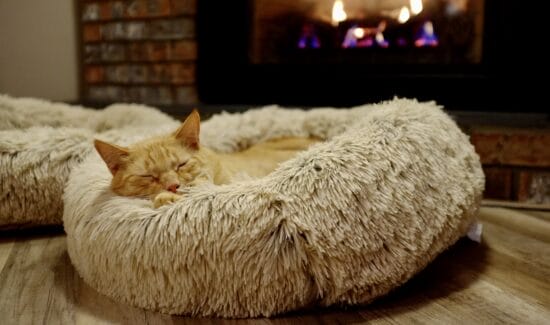
Nest-like cat beds are a popular choice among feline enthusiasts, and it’s no wonder why. These cozy little havens provide the perfect spot for our furry friends to curl up and relax. With their plush sides and soft cushioning, nest-like cat beds offer a sense of security that can’t be beaten.
Cats are drawn to nest-like beds because they mimic the feeling of being nestled in their mother’s embrace. The raised sides create a safe, enclosed space where your cat can rest undisturbed. This feeling of being cradled can help reduce anxiety and promote better sleep.
In addition to providing comfort, nest-like cat beds serve as a warm retreat during colder months. Cats love warmth, so having a bed with high sides helps retain body heat and keeps them snug throughout the night.
Moreover, these beds frequently offer a variety of shapes and sizes, making it easier for you to discover the ideal match for your beloved feline companion. Whether they prefer round or oval-shaped nests, there is sure to be an option that suits their individual preferences.
So, if you’re wondering why your cat sometimes chooses to sleep between your legs instead of their fancy bed, remember that it may simply be due to instinctual habits kicking in or seeking extra warmth from you! But when they opt for their sanctuary – like a nest-like cat bed – rest assured knowing they have found solace in their little haven!
Cat Caves:
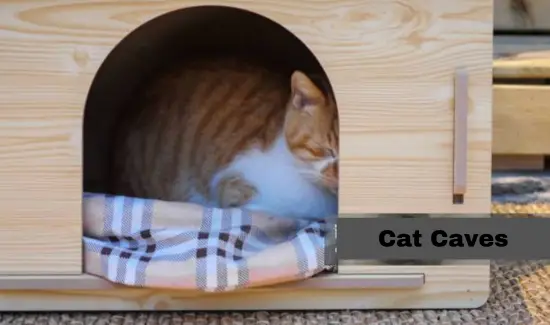
Cat caves, which resemble small caves or dens, are another popular sleeping arrangement for cats. These enclosed beds offer a sense of privacy and security that many cats crave.
The unique design of cat caves mimics the feeling of being nestled in a warm, protected environment. The soft padded walls create a comforting cocoon-like experience that can aid in reducing anxiety and encouraging improved sleep.
Additionally, cat caves often have an open top or entrance, allowing cats to enter and exit easily while enjoying the enclosed feeling. This feature makes it convenient for your furry friend to snuggle up between your legs without disturbing your comfort.
Cat Hammocks:
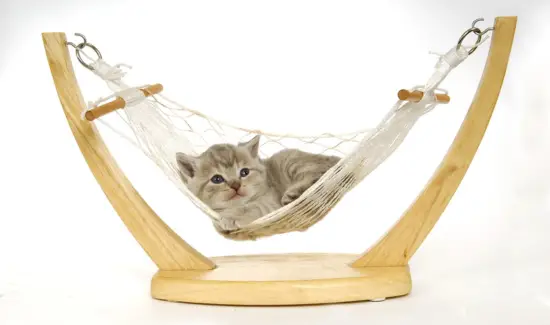
Hammocks are no longer just for humans! You can find a variety of cat hammocks designed to attach to chairs or windowsills, Creating a Relaxing Spot for Your Cat to Unwind.
These can be easily made at home using basic materials such as solid fabric (such as denim or canvas), wooden dowels or PVC pipes, and heavy-duty rope.
Cut two pieces of fabric into equal rectangles and sew three sides together, leaving one side open for inserting the dowel later.
Next, attach each end of the dowel to two pieces of rope using knots or ties. Secure each rope to a sturdy surface, such as a window ledge or under a table, where your cat can comfortably lay in its new hammock.
If you have multiple cats who love cuddling together while sleeping, consider making more giant hammocks to accommodate them all at once. Add extra cushioning or fleece material to the hammock for added comfort.
Cat Wall- Shelves:
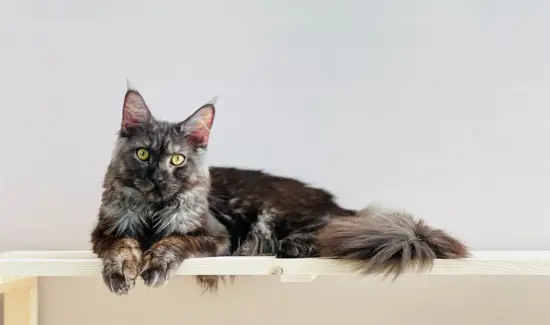
Cat wall- shelves are a great addition to any cat-friendly home. They not only provide your feline friend with an elevated place to sleep, but they also save space in smaller homes. The first step in creating DIY cat shelves is choosing the suitable materials.
You can use sturdy wooden planks or even repurpose old bookshelves or wall shelves for the shelf. Make sure they are securely attached to the wall using brackets or screws for safety.
Next, consider adding soft and comfortable material on the shelf for your cat to rest on. This could be a piece of fleece fabric or a soft blanket folded over several times. You can even sprinkle some catnip on top of the material to make it more appealing to your cat.
Window Perch:
Window perches are another excellent option for providing your feline friend with a comfortable sleeping place that is not between your legs.
Cats instinctively seek out elevated spots because they grant them a secure vantage point for observing their environment. This instinct makes window perches and sill beds perfect for your cat to lounge and nap.
A window perch is typically attached to the windowsill or mounted on the wall near a window. It provides an elevated platform for your cat to rest on and gives it a prime view of the outside world.
These perches come in various sizes and styles, ensuring your cat a cozy resting spot to bask in the sun and watch birds flutter.
Sill Beds:
Sill beds, also known as window hammocks, are similar to window perches but have the added comfort of a soft cushion or bed attached. They can be easily installed by placing suction cups on both sides of the window frame, creating a comfy lounging spot for your feline companion. Sill Beds Come in Various Shapes and Sizes to Match Your Cat’s Preferences.
Window perches and sill beds are fantastic alternatives to keep your feline friend comfortable while sleeping. They provide security, promote physical health, and satisfy their instincts. With various options available in the market, you can easily find one that suits your cat’s needs and preferences.
Cat Tree and Towers with Sleeping Platforms:
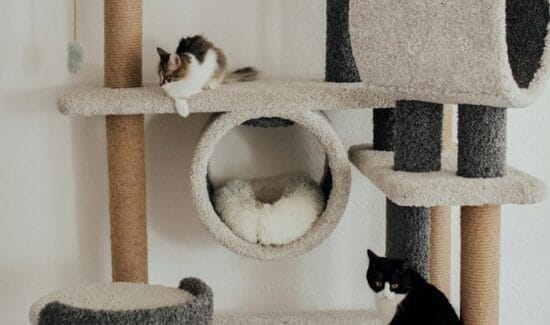
Cat trees and towers are famous for providing cats with comfortable sleeping spots. These structures provide a cozy place for your feline friend to rest and serve as a form of enrichment and exercise.
Cat trees and towers come in a variety of sizes, shapes, and designs, Ensuring You Find the Perfect Match for Your Cat’s Preferences.
Cat trees and towers mimic a cat’s natural environment by providing high perches for observing their surroundings.
Domestic cats deeply ingrained this behavior, as it allows them to feel safe while still being able to watch for predators. Additionally, these elevated perches fulfill your cat’s innate desire to climb and jump, promoting physical activity and mental stimulation.
Consider your cat’s size and weight when choosing a cat tree or tower. The structure should be sturdy enough to support your cat’s weight without wobbling or tipping over. You should choose one with multiple levels or platforms so your cat can quickly move up and down without getting stuck.
The material used is another crucial factor when selecting a cat tree or tower. Select long-lasting materials such as wood or heavy-duty cardboard. Avoid those made from flimsy materials such as cheap plastic, as they may not withstand your energetic feline’s daily wear and tear.
One thing that makes cat trees and towers so appealing is their versatility. They come with different features, such as scratching posts, dangling toys, hideaway boxes, and hammocks, all designed to cater to different aspects of a cat’s lifestyle.
Scratching posts help satisfy cats’ need to scratch while protecting your furniture from damage. Dangling toys provide entertainment while promoting playtime activities that stimulate cats mentally.
Blanket or Towel in a Quiet Corner:
Sometimes, a simple blanket or towel placed in a quiet, secluded corner of your home can be a perfect sleeping spot for a cat.
Heating Pad or Warm Blanket:
A heating pad or a self-warming cat blanket could be a good alternative if your cat seeks warmth by sleeping between your legs.
Cardboard Box:
Many cats love cardboard boxes. Place a soft blanket inside a box to make it more comfortable.
Dedicated Chair or Cushion:
Designate a chair or a cushion in a quiet part of your home where your cat can rest undisturbed.
Soft Pile of Laundry:
Some cats find a soft pile of laundry irresistible. You can mimic this by creating a similar, clean pile in a basket.
Interactive Pet Beds:
Pet beds that mimic the feel of an animal’s fur are available, which might comfort your cat.
Your Clothes:
If your scent attracts your cat, consider placing an item of your clothing where you’d like them to sleep.
Every cat has preferences, so finding the perfect spot might take trial and error. Also, ensure the sleeping area is safe, cat-friendly, and away from too much noise or foot traffic.
Scientific Explanations:
There are multiple scientific explanations behind why our furry friends choose the spot between our legs as a preferred sleeping spot. Whether it’s for warmth, security, physical support, or social bonding, it’s clear that this behavior is rooted in a cat’s instincts and needs. So the next time your cat curls up between your legs for a nap, remember that it’s their way of showing love and trust towards you.
Additionally, some experts believe that the position of sleeping between the legs mimics the feeling of being nestled alongside littermates or their mothers as kittens. This brings about feelings of comfort and security for adult cats as well.
Not all cats will exhibit this behavior – some may prefer other spots, such as next to or on top of their owner.
How to Encourage or Discourage This Behavior:
Cats are known for their independent and sometimes unpredictable behavior. One common habit many cat owners have noticed is their feline friends sleeping between their legs. While it can be cute and comforting to have your furry companion snuggled up against you, it can also be disruptive and uncomfortable sometimes. So, how can you encourage or discourage this behavior in your cat? Here are a few tips to help you out.
Encouraging the Behavior:
1. Provide Comfortable Sleeping Options:
Cats love soft and cozy sleep places, so ensure they have comfortable bedding options. This will keep them warm and content and divert their attention from sleeping between your legs.
2. Positive Reinforcement:
If you want to encourage your cat to sleep somewhere else, reward them when they do so. For instance, if they choose to nap in their bed instead of between your legs, give them treats or praise them with affectionate words.
3. Create a Safe Space:
Cats seek comfort in familiar spaces where they feel safe and secure. Create a designated area for your cat by placing a bed or blanket in a quiet corner of the house. This will give the cat a sense of belonging and reduce the chances of seeking alternative sleeping spots, like between your legs.
Discouraging the Behavior:
1. Firm Boundaries:
Cats are creatures of habit, so firm boundaries are essential when discouraging certain behaviors, like sleeping between your legs. Gently push them away whenever they try to settle down on your lap or legs.
2. Distractions:
If your cat tries to sleep between your legs at specific times (like while watching TV), distract it with toys or other forms of entertainment before it gets settled in that spot.
3. Make It Uncomfortable:
Another way to discourage this behavior is by making it physically uncomfortable for your cat. Place a pillow or cushion between your legs to create an uneven surface, making it less appealing for them to sleep there.
Remember, every cat is different, and what works for one may not work for another. Being patient and consistent when encouraging or discouraging this behavior in your feline friend is essential. With time and persistence, you can train your cat to sleep in other areas of the house, leaving you with uninterrupted leg space at night.
Final Thoughts:
After learning about the various reasons why cats may choose to sleep between your legs, it is clear that this behavior is not random or meaningless. Cats Showcase Distinct Personalities and Preferences, Mirrored in Their Sleep Patterns.
Cat owners should observe their feline friend’s sleeping behaviors to understand them better and strengthen the bond between pet and owner.
Owners can gain insight into their cat’s physical and emotional well-being by observing their cat’s sleep patterns, body language, and overall behavior while they sleep.
Understanding why cats enjoy sleeping between their owner’s legs can also help create a more comfortable environment. Providing a warm and cozy bed or designated area for your cat to sleep in can make them feel safe and secure while satisfying their need for warmth and comfort.
Furthermore, respect your cat’s space between sleepless when sleeping. As much as we love our pets’ cuddles, we must allow them to move around during their sleep without disturbing them. This will ensure that they get quality rest without feeling constrained or uncomfortable.
Various possible explanations exist for why cats enjoy sleeping between their owner’s legs. It could be due to instinctual behaviors from their wild ancestors or simply because they find comfort in being close to those they trust. No matter the reason, this behavior shows that cats have deep trust and affection for their human companions.
As dedicated pet caretakers, we must understand our cats’ needs and establish a safe environment that enhances their physical and emotional wellness. So the next time you find your furry friend snuggled up between your legs, remember that it is a sign of love and trust from your feline companion. Embrace this special bond with appreciation and respect, and your cat will continue to choose you as its favourite napping spot.


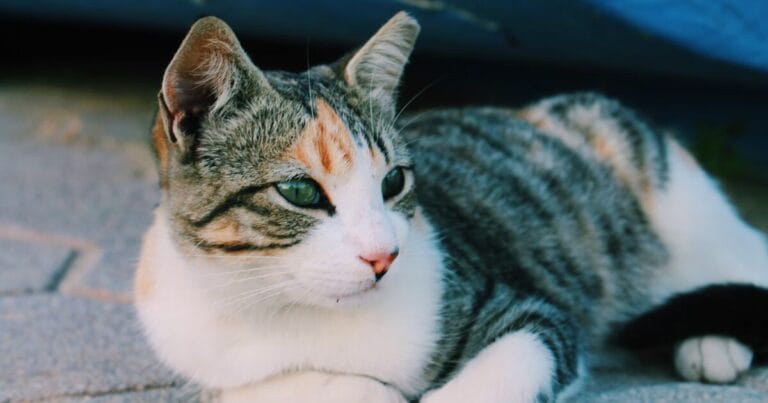
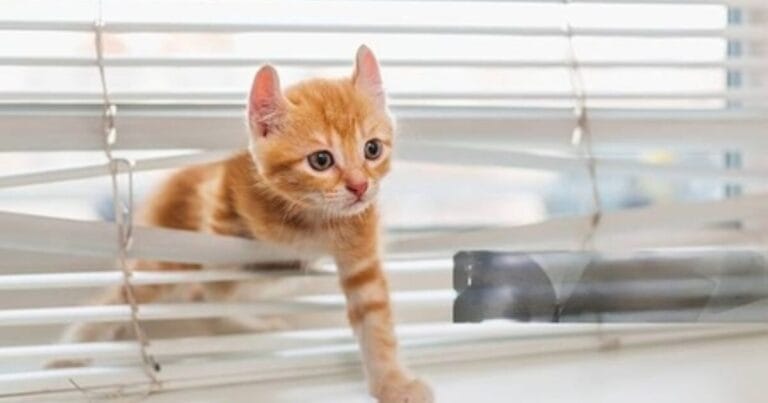
Hi i think that i saw you visited my web site thus i came to Return the favore Im attempting to find things to enhance my siteI suppose its ok to use a few of your ideas
sure why not
I just could not leave your web site before suggesting that I really enjoyed the standard information a person supply to your visitors Is gonna be again steadily in order to check up on new posts
Thanks a lot